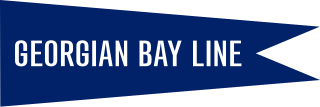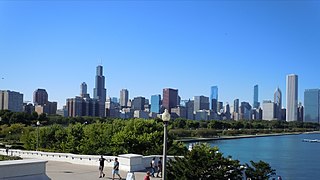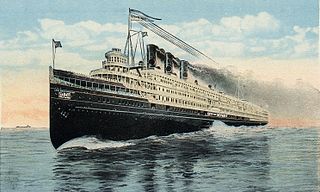This article includes a list of general references, but it lacks sufficient corresponding inline citations .(December 2014) |
Detroit and Cleveland Navigation Company, often abbreviated as D&C, was a shipping company on the Great Lakes.
This article includes a list of general references, but it lacks sufficient corresponding inline citations .(December 2014) |
Detroit and Cleveland Navigation Company, often abbreviated as D&C, was a shipping company on the Great Lakes.
The main route was between Detroit, Michigan, and Cleveland, Ohio. Routes also lead to Buffalo, New York with the purchase of the Detroit and Buffalo Steamship Company in 1909. Charters and day-trips were also offered. Most scheduled sailings were overnight sailings, landing in the morning after departure. Each ship was painted with a black hull and white superstructure and white lettering. By 1949, the ships wore all-white paint with blue lettering. The popular line operated from 1868 to 1951 and is often referred to as the owner of many of the Great Lakes' best "floating palaces" and "honeymoon ships".

In its heyday, the D&C Line was among the most well-known shipping companies in business on the Great Lakes, with its vessels being among the largest and most palatial ever seen. Two of them, SS Greater Buffalo and the SS Greater Detroit, were both built in 1923, and were known as the largest side-wheeler passenger ships in the world. Naval architect Frank E. Kirby designed many D&C ships. As ferry and cruise ships, all of the ships of D&C were a success, with various civic groups and companies often chartering each ship on account of their reputations for excellent services and good cuisine. Upon reaching Buffalo, happy honeymoon couples would connect to Niagara Falls. In the late 1930s, the increasing use of the automobile caused passenger numbers to slowly fall.
During World War II, Greater Buffalo was converted into training aircraft carriers for use on the Great Lakes. In the meantime, Greater Detroit and her fleetmates saw an increase in passenger revenues, with the ships being reasonably full as Americans rationed gasoline for the war effort and therefore chose to travel between cites on the D&C liners, among other lines operating then.
By the end of the war, revenues fell again. Greater Detroit and her fleetmates, the City of Cleveland III , City of Detroit III , Western States , and the Eastern States , were all that remained. On June 26, 1950, the 390-foot (120 m)-long City of Cleveland III was struck abaft by the Norwegian freighter Ravenfjell , and was severely damaged. Five passengers were killed in the collision, with dozens injured. The two ships survived and returned to their ports, but this incident, along with the dramatic resurgence of the automobile and truck traffic trades, finished the company. The company was formally dissolved in 1951, shortly after their old harbor terminals were condemned by the city of Detroit because of old age, and by 1959, most of the line's remaining ships had been scrapped. Greater Detroit and Eastern States in particular had their wooden upper works set afire before their steel hulls were scrapped at the Steel Company of Canada.
Western States, after finding herself laid up by 1951, was towed to Tawas City, Michigan on Lake Huron in 1955 to become a floating hotel. Overniter Inc. was her owner and the vessel was unofficially renamed Overniter. When the "flotel" idea proved to be unprofitable, Siegel Iron & Metal Company of Detroit purchased her. After a dockside fire in 1959, she was scrapped by Michigan-based Bay City Scrap Company at the old Davidson Shipyard.
Greater Buffalo was declared surplus by the United States Navy and scrapped in 1948.
One vessel built in 1883, the 203-foot (62 m) long, 807 ton City of Mackinac (renamed State of New York in 1893 by the Cleveland and Buffalo Line) was sold back to D&C in 1909. The City of Mackinac was later converted into the floating clubhouse of the Chicago Yacht Club (from 1936 to 2004) and was the last known vessel of the D&C Line to survive.
When the City of Detroit III was dismantled in 1956, Frank Schmidt bought the wooden fittings from the Gothic Room aboard the steamer and had the material shipped to suburban Cleveland. After his death, the Dossin Great Lakes Museum on Belle Isle in the Detroit River acquired the woodwork and a part of the large and elegant room was preserved there as a reminder of the D&C Line's past glory days.
It was not until the arrival of the German HAPAG ship c. Columbus in 1997 that such large and well-accommodated overnight passengers ships had been seen on the Great Lakes.
Along with the Hudson River Day Line, the Georgian Bay Lines, Great Lakes Transit Company, Canada Steamship Lines, Fall River Line, Old Bay Line, among other lines, the D&C Line is considered to be among the major passenger shipping companies of America's inland and coastal waterways. It was a people mover and a catalyst for the development of numerous towns and ports at a time when better automobile and trucking routes, along with larger bridges, were yet to be built and established.

The New York Central Railroad was a railroad primarily operating in the Great Lakes and Mid-Atlantic regions of the United States. The railroad primarily connected greater New York and Boston in the east with Chicago and St. Louis in the Midwest, along with the intermediate cities of Albany, Buffalo, Cleveland, Cincinnati, Detroit, Rochester and Syracuse. New York Central was headquartered in New York City's New York Central Building, adjacent to its largest station, Grand Central Terminal.
The Pere Marquette Railway was a railroad that operated in the Great Lakes region of the United States and southern parts of Ontario in Canada. It had trackage in the states of Michigan, Ohio, Indiana, and the Canadian province of Ontario. Its primary connections included Buffalo; Toledo; and Chicago. The company was named after Jacques Marquette, a French Jesuit missionary who founded Michigan's first European settlement, Sault Ste Marie.

USS Michigan was the United States Navy's first iron-hulled warship and served during the American Civil War. She was renamed USS Wolverine in 1905.

The Michigan Central Railroad was originally chartered in 1832 to establish rail service between Detroit, Michigan, and St. Joseph, Michigan. The railroad later operated in the states of Michigan, Indiana, and Illinois in the United States and the province of Ontario in Canada. After about 1867 the railroad was controlled by the New York Central Railroad, which later became part of Penn Central and then Conrail. After the 1998 Conrail breakup, Norfolk Southern Railway now owns much of the former Michigan Central trackage.

USS Sable (IX-81) was a United States Navy training ship during World War II, originally built as the passenger ship Greater Buffalo, a sidewheel excursion steamboat. She was purchased by the Navy in 1942 and converted to a training aircraft carrier to be used on the Great Lakes. She lacked a hangar deck, elevators, or armament and was not a true warship, but she provided advanced training of naval aviators in carrier takeoffs and landings.

USS Wolverine (IX-64) was a training ship used by the United States Navy during World War II. She was originally named Seeandbee and was built as a Great Lakes luxury side-wheel steamer cruise ship for the Cleveland and Buffalo Transit Company. Seeandbee was launched on 9 November 1912 and was normally used on the Cleveland, Ohio, to Buffalo, New York, route with special cruises to other ports. After the original owners went bankrupt in 1939 Seeandbee was purchased by Chicago-based C & B Transit Company and continued operating until 1941.

Chief Wawatam was a coal-fired steel ship that was based, for most of its 1911–1984 working life, in St. Ignace, Michigan. The vessel was named after a distinguished Ojibwa chief of the 1760s. In initial revenue service, the Chief Wawatam served as a train ferry, passenger ferry and icebreaker that operated year-round at the Straits of Mackinac between St. Ignace and Mackinaw City, Michigan. During the winter months, it sometimes took many hours to cross the five-mile-wide Straits, and Chief Wawatam was fitted with complete passenger hospitality spaces.

The Georgian Bay Line is the popular name of the Chicago, Duluth and Georgian Bay Transit Company. From 1913 until 1967, the Georgian Bay Line (GBL) provided transit service and cruise voyages to passengers on North America's Great Lakes.

Vacationland was an automobile ferry that operated in Michigan's Straits of Mackinac between Mackinaw City and St. Ignace from 1952 to 1957, when the Mackinac Bridge was completed.

The SS Christopher Columbus was an American excursion liner on the Great Lakes, in service between 1893 and 1933. She was the only whaleback ship ever built for passenger service. The ship was designed by Alexander McDougall, the developer and promoter of the whaleback design.

The history of commercial passenger shipping on the Great Lakes is long but uneven. It reached its zenith between the mid-19th century and the 1950s. As early as 1844, palace steamers carried passengers and cargo around the Great Lakes. By 1900, fleets of relatively luxurious passenger steamers plied the waters of the lower lakes, especially the major industrial centres of Chicago, Milwaukee, Detroit, Cleveland, Buffalo, and Toronto.
The Mackinac Transportation Company was a train ferry service that shuttled railroad cars across the Straits of Mackinac from 1881 until 1984. It was best known as the owner and operator, from 1911 until 1984, of the SS Chief Wawatam, an icebreaking train ferry.

The Great Lakes megalopolis consists of a bi-national group of metropolitan areas in North America largely in the Great Lakes region. It extends from the Midwestern United States in the south and west to western Pennsylvania and Western New York in the east and northward through Southern Ontario into southwestern Quebec in Canada. It is the most populated and largest megalopolis in North America.

SS Aquarama was built as Marine Star, one of five breakbulk cargo ships of the United States Maritime Commission (USMC) type C4-S-B5 having that C4 design variant. The ship was delivered to the War Shipping Administration (WSA) for operation in July 1945 just before the end of World War II and was operated until August 1946 by WSA's agent American Hawaiian SS Company. From September 1947 the ship was laid up except for brief periods in the James River.

City of Detroit III, often referred to as just D-III, was a sidewheel steamer on the Detroit River and Lake Erie. She was one of the largest sidewheelers on the Great Lakes.
Queen of the Lakes is the unofficial but widely recognized title given to the longest vessel active on the Great Lakes of the United States and Canada. A number of vessels, mostly lake freighters, have been known by the title.

Due to its unique geography, being made of two peninsulas surrounded by the Great Lakes, Michigan has depended on many ferries for connections to transport people, vehicles and trade. The most famous modern ferries are those which carry people and goods across the Straits of Mackinac to the car-free Mackinac Island but before the Mackinac Bridge was built, large numbers of ferries carried people and cars between the two peninsulas. Other ferries continue to provide transportation to small islands and across the Detroit River to Canada. Ferries once provided transport to island parks for city dwellers. The state's only national park, Isle Royale cannot be reached by road and is normally accessed by ferry. The largest ferries in Michigan are the car ferries which cross Lake Michigan to Wisconsin. One of these, the SS Badger is one of the last remaining coal steamers on the Great Lakes and serves as a section of US Highway 10 (US 10). The Badger is also the largest ferry in Michigan, capable of carrying 600 passengers and 180 autos.

SS Greater Detroit was a sidewheel steamer on Lake Erie that was launched in 1923. It was operated by the Detroit and Cleveland Navigation Company and carried passengers between Detroit, Michigan and Buffalo, New York. Greater Detroit and her sister ship, SS Greater Buffalo, were the largest and most expensive sidewheel steamers in the world at the time of their launching, and were capable of transporting more passengers than many oceangoing liners of the time. They were renowned for their onboard luxury, decor and modern amenities. Nicknamed the "Leviathan of the Great Lakes", Greater Detroit was in passenger service for 26 years until 1950, when she became too expensive to continue to operate. The ship was sold for scrap in 1956.
Overlakes Freight Corporation was shipping agent company founded in New York City on April 21, 1932, by William M. Nicholson. Overlakes Freight Corporation operated Liberty Ships during and for post World War II efforts. Most of Overlakes Freight Corporation ships were purchased by the War Shipping Administration for the war. Nicholson also owned the Nicholson Universal Steamship Company, Nicholson, Erie, Dover, Ferry Line, Nicholson Terminal & Dock Company, Aqua Terminal & Dock Corporation and the Nicholson Transit Company.